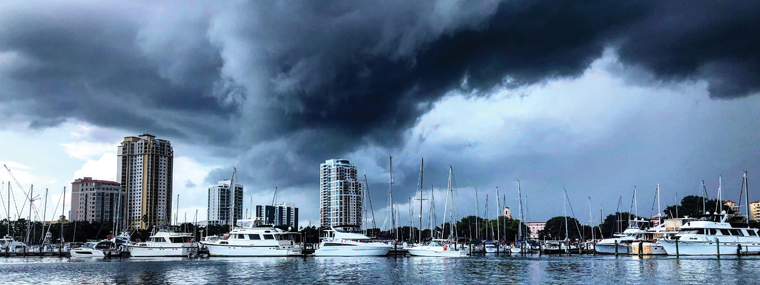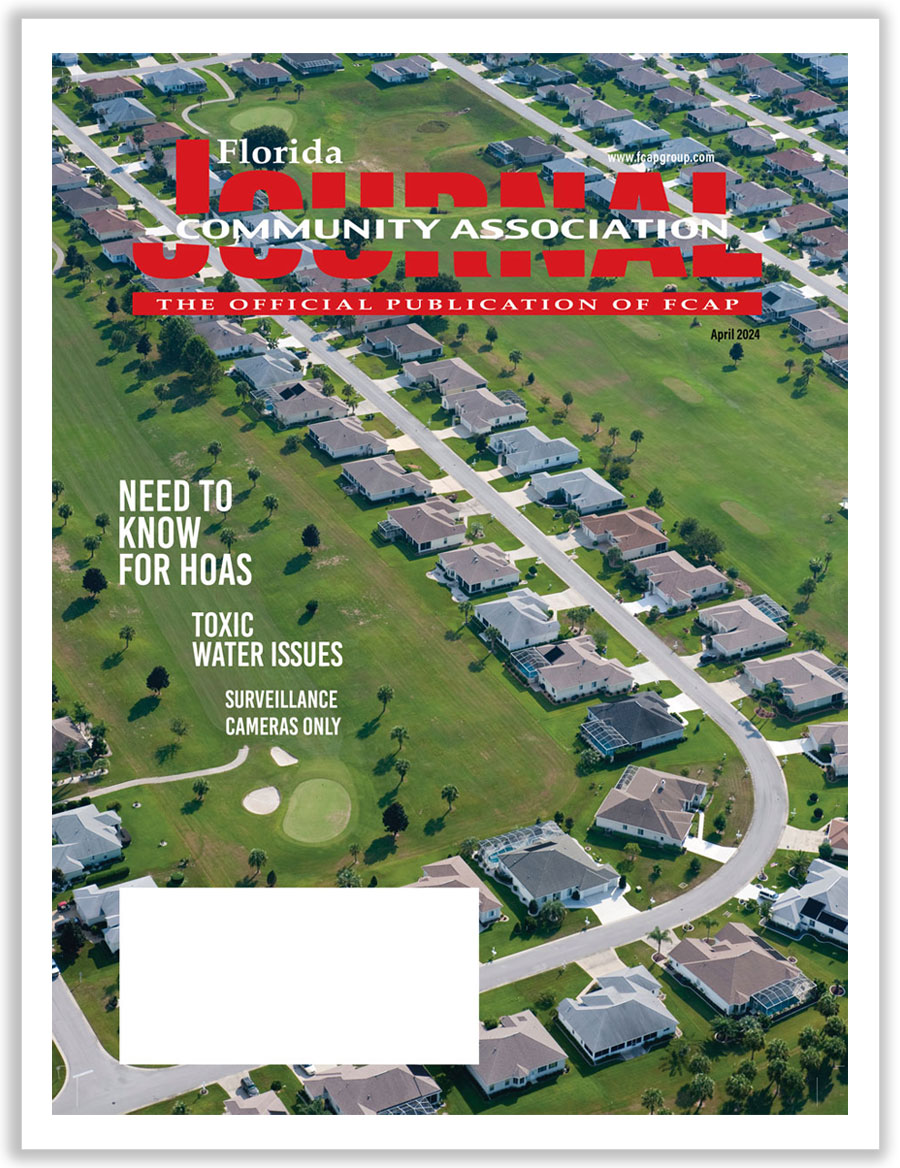
Are You Ready?
Hurricane Season June 1–November 30
By Dania S. Fernandez, Attorney at Law, & Louis Petrole, Architect

As hurricane season is upon us once again, it’s time to dust off community hurricane preparedness plans in order to protect our community’s members and residents. As you know, an action plan for safety and preservation is crucial before, during, and after the storm.
Your community’s preparedness plan should anticipate the possibility of a total casualty loss and permanent or temporary relocation of residents. Since Hurricane Andrew in 1992, which caused an estimated $27 billion dollars of damage, many people have become complacent regarding the devastation which can be caused by a storm. Florida’s population is estimated to have increased from 13.6 million to 20.6 million since 2016 alone, with a large swath of the population who have never experienced the devastating effects of a category 4 hurricane.
The first step to creating the community’s plan of action is to create your disaster/evacuation team. Create a committee that is willing to take on the task.
[adrotate group=”1″]
As the board of directors has the power to create committees, place an agenda item to create a disaster/evacuation committee at your next open board meeting. This committee can serve as facilitators for the board, management, and the community and can help guide owners and call for help when help is needed. The board should give this committee the authority to implement a plan of action.
Pre-Storm Preparation
Gather information:
- Owner/resident information—Current roster with telephone, email, address, and next of kin.
- Directory—Names and contact information of the disaster/evacuation team, volunteers, management, and maintenance personnel. Distribute the directory to members/residents.
- Insurance policies—Agent name and contact information.
- Employee information—Telephone, email, address, and next of kin.
- Vendor list—Maintenance, CPA, insurance agent, attorney, manager, contractors, engineers, and architect.
- Banking information—Bank representative’s contact information, account numbers, authorized signers, and certificates of deposit.
- Building plans—Architectural plans and specifications, engineering/civil, engineering/structural and mechanical, as-built drawings, location of shut off-valves and structural components, names and contact information for engineers, contractors, subcontractors, and architect who designed or has worked for the community.
- Volunteers—Ask them to be in contact with the disaster/evacuation team and management to distribute information to the residents when needed.
Document, document, document:
- Photograph and videotape all areas of the property, both interior and exterior.
- Walk the community with a licensed architect or engineer. Have them provide a report of their findings with reference to the community’s roof, structure, and windows.
- Ask residents to take pictures of the interior of their homes.
- Create an inventory of any supplies owned by the association, such as vans, golf carts, walkie-talkies, maintenance supplies, generators, fire extinguishers; preserve all receipts & serial numbers. Photograph and write descriptions.
Preserve official records:
- Regularly back up all data and official records to a safe, accessible location.
- Scan and keep a stored copy.
Emergency supplies:
- Gather backup supplies such as water, fuel for generators, flashlights, etc.
- Store on-site mitigation materials and tools for staff to use after the storm has passed.
Set policies and procedures:
- Distribute planned procedures residents are to follow, such as unit preparations (shutters and balcony clearing), evacuation procedures for all residents, and critical phone contacts for updates.
- Determine procedures and wind speed evaluations for the shutdown of cooling towers and elevators by maintenance staff.
- Designate two to three people as first responders. Make certain they have the preparedness guide and all contact information for the board of directors, residents, vendors, insurance agents, managers, and association attorney.
- Establish procedures and protocol for partial or complete shutdown of the building and for an evacuation order for those residents refusing to evacuate.
Collaborate with Vendors:
- Pre-negotiate with all critical vendors (roofer, architect, engineer, and structural repairs specialists.)
- Arrange to be at the top of their list.
- Meet with your insurance agent; ensure the community has appropriate coverage.
- Meet with your manager and discuss cleanup and repair. Much of the debris cleanup can be coordinated with management.
During The Storm
This will vary based on the location and type of structure of the condominium, such as being in a coastal evacuation zone, inland, low-rise or high-rise structure, etc.
- Residents remaining within the structure should have preplanned information and procedures set during the pre-storm preparedness.
- The storm’s severity, building location in relation to the storm, etc., will determine if management has staff on site. If the building has been evacuated, management will have to monitor and update staff and residents via text or website updates as to ongoing status of the building and when they can return.
- The storm should be documented through photos and video of any damage it is causing if that can be done safely.
After The Storm
This again will depend on building size, location, and storm impact.
Management and maintenance staff would return to the property when it was determined “safe” by county or city notifications.
Safety First:
- Activate the designated first responders and critical vendors.
- Determine if any residents who remained in the building need immediate assistance, following the prearranged process of checking on all residents within the building.
- Allow first responders to examine all areas of the property exterior and interior common elements, including stairwell doors, mechanical rooms, roof, roof fans, cooling towers, etc. All areas must be photographed. Many times, wind or water damage to the structure or roof itself may not be immediately visible, becoming evident in the future.
- Decide what work would be required to be repaired by the condominium association (immediate mitigation work) and what issues are city related (damaged power feeds, water lines, etc.)
- Start your maintenance staff on cleanup and mitigation repairs (temporary) to all damaged areas.
- Have pre-arranged vendors visit the property for cleanup, debris removal, temporary roof patching, electrical repairs, water intrusion, and water damage mitigation, etc.
- Communicate to all owners via the pre-arranged procedures to inform residents of the condition of the building and if it is safe to return
- Depending on the storm severity and building location, management along with the designated critical vendor may need to visually check each condominium unit for water intrusion or damage and begin mitigation procedures.
Form Your Professional Team:
- Team of professionals—Bring in the architect/engineer, construction manager, project manager, general contractor, insurance agent, and attorney. They will need to assess the damage and contracts will need to be reviewed and negotiated.
- Funding Repairs—Consider having a construction fund; meet with the community’s banking representative and attorney.
- Insurance Claim—Call your insurance agent. Be aware that the adjuster sent by the insurance carrier is not motivated to get you the most money possible. Also, when hiring a public adjuster to represent the community, remember that a public adjuster cannot perform any activities restricted to the practice of law, such as filing a lawsuit to collect monies from your insurance company. Consult your attorney before signing a contract with a public adjuster and before the insurance carrier sends their adjuster to estimate the damages.
Dania S. Fernandez
Attorney at Law, Dania S. Fernandez & Associates, P.A.
We are offering a free online webinar to guide your disaster/evacuation team in preparing and finalizing your community’s hurricane preparedness plan. All participants will receive a sample guide and will participate in an active discussion on how to create a working plan. Please contact Dania S. Fernandez, Esq., at dania@dsfpa.com or via telephone at (305) 254-4492; or contact Louis Petrole, AIA assco., ASLA at louisba@att.net or via telephone at (305) 534-2442.
Louis Petrole
Architect, Dania S. Fernandez & Associates, P.A.





